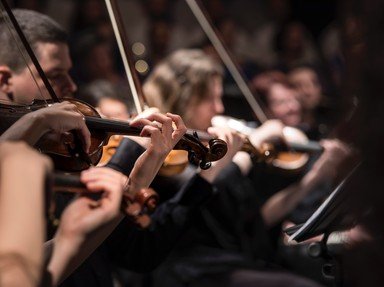Quiz Answer Key and Fun Facts
1. Alongside Dargomizhsky, this composer is regarded as one of the founders of the Russian national music school. His most valuable works are two operas: "A Life for the Tsar", and "Ruslan and Ludmila", with a libretto by Pushkin.
2. A member of "The Five", he was less prolific than the other group members, but he left us several works with an intense oriental color. The most famous of them is the opera "Prince Igor", which includes moments of rare beauty, like the charming choral dances, the "Polovtsian Dances", expressing an ardent vitality.
3. Another important member of the nationalist group of "The Five" is Modest Moussorgsky. Which composition is considered his most important work - a picturesque opera, unique for its variety and intensity of expression ?
4. Also a member of "The Five", Nikolay Rimsky-Korsakov is generally known for his colorful orchestral compositions. Which of the following is one of his most praised works?
5. Among many other qualities of his prolific work, Tchaikovsky was the master of the miniature forms required by a certain form of art that had been constantly developing in the XIX th century Russia, under the guidance of French dancer Marius Petipa. Which was this relatively new attraction for which Tchaikovsky provided some amazing music scores?
6. Alexander Scriabin is definitely an unique, and, to a certain extent, eccentric composer. Which instrument has a preeminent role in about three quarters of his over one hundred works?
7. He is unquestionably one of the greatest pianists of all time. Following the Russian Bolshevik Revolution in 1917, he fled his country and emigrated to America, where he became a US citizen. Although his artistic career as a piano performer left him little time for composition, his piano works are still some of the most admired compositions for this instrument.
8. Igor Stravinsky is first of all a genial innovator, sometimes regarded as Picasso's counterpart in music. His innovative, contrasting style had been revelatory to the young generation of musicians. Which are his first two masterpieces, still faithful to the Russian tradition?
9. Sergei Prokofiev is one of the greatest composers of the XX th century. He excelled in a wide range of musical genres and he has been very well received by the public both in the Occident and in his native Russia. Which is one of his most popular operas?
10. Despite the suffocating political climate, Soviet Russia trained a new, young and talented generation of musicians and composers. Which one of them is most appreciated for his cycles of symphonies and string quartets (15 of each)?
Source: Author
Mr5
This quiz was reviewed by FunTrivia editor
agony before going online.
Any errors found in FunTrivia content are routinely corrected through our feedback system.
